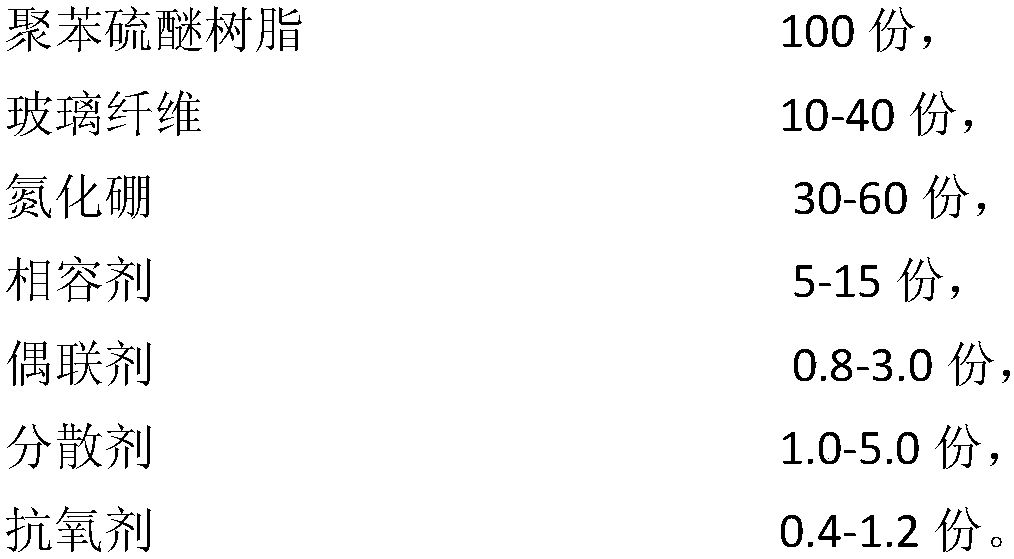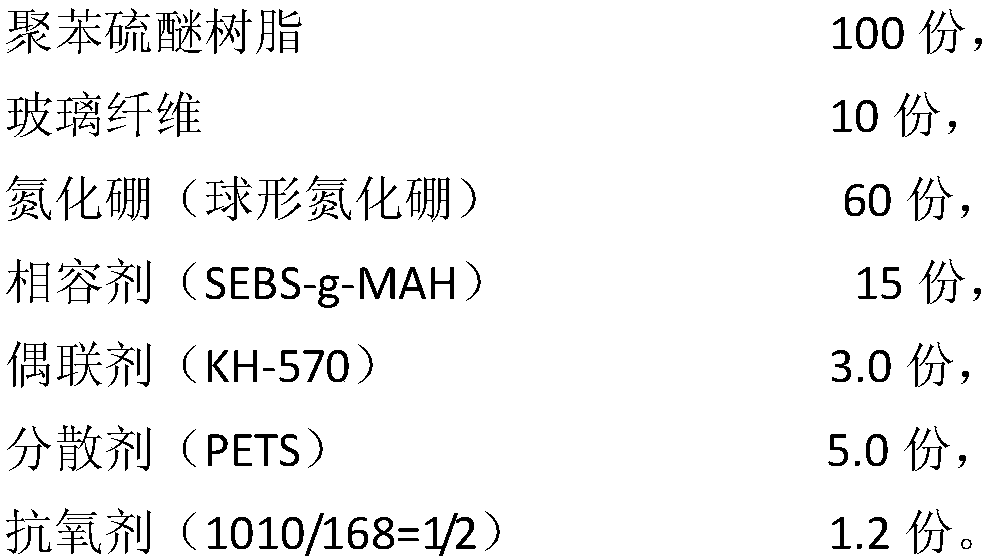High-thermal-conductivity low-dielectric-loss polyphenylene sulfide composite and preparation method thereof
A technology of composite materials and polyphenylene sulfide, which is applied in the direction of heat exchange materials, chemical instruments and methods, etc., can solve the problems of limited application, influence on wave permeability, poor thermal conductivity of polyphenylene sulfide, etc., and achieve excellent low Dielectric properties, improved mechanical properties, and low dielectric loss
- Summary
- Abstract
- Description
- Claims
- Application Information
AI Technical Summary
Problems solved by technology
Method used
Image
Examples
preparation example Construction
[0039]
[0040] A kind of preparation method of modified polyphenylene sulfide composite material, it comprises the following steps:
[0041] (1), 30-60 parts of boron nitride and 0.8-3.0 parts of coupling agent are mixed to obtain the first mixture;
[0042] (2), 1.0-5.0 parts of dispersant are added to the first mixture, and the second mixture is obtained after mixing;
[0043](3) After mixing 100 parts of polyphenylene sulfide resin, 5-15 parts of compatibilizer and 0.4-1.2 parts of antioxidant, add it from the main feeding port of the screw extruder, and extrude the second mixture from the screw The side feeding port of the extruder is added, and 10-40 parts of glass fiber is added from the glass fiber inlet of the screw extruder, extruded and granulated by the screw extruder, and the modified polyphenylene sulfide compound in the form of pellets is obtained. Material. The main feeding port is located in the first area of the barrel, the glass fiber port is located i...
Embodiment 1
[0050] This embodiment provides a modified polyphenylene sulfide composite material, the production raw materials of which include the following components:
[0051]
[0052] Wherein, the above polyphenylene sulfide resin has a melt index of 500 g / 10 min.
[0053]
[0054] This embodiment also provides a method for preparing a modified polyphenylene sulfide composite material, which includes the following steps:
[0055] (1) Add 60 parts of boron nitride (spherical boron nitride) and 3.0 parts of coupling agent (KH-570) into a high-speed mixer, and mix at a temperature of 60°C for 6 minutes at a speed of 500 rpm to obtain the first mixture ;
[0056] (2) Add 5.0 parts of dispersant (PETS) to the first mixture in step (1), and continue to mix at a temperature of 120° C. for 15 minutes at a speed of 1000 rpm to obtain a second mixture;
[0057] (3), put 100 parts of polyphenylene sulfide resin, 15 parts of compatibilizer (SEBS-g-MAH) and 1.2 parts of antioxidant (1010 / 168...
Embodiment 2
[0060] This embodiment provides a modified polyphenylene sulfide composite material, the production raw materials of which include the following components:
[0061]
[0062] Wherein, the above polyphenylene sulfide resin has a melt index of 900 g / 10 min.
[0063]
[0064] This embodiment also provides a method for preparing a modified polyphenylene sulfide composite material, which includes the following steps:
[0065] (1) Add 30 parts of boron nitride (boron nitride fiber) and 0.8 parts of coupling agent (KH-550) into a high-speed mixer, and mix at a speed of 200 rpm for 3 minutes at a temperature of 30°C to obtain the first mixture ;
[0066] (2) Add 1.0 parts of dispersant (EBS) to the first mixture in step (1), and continue to mix at a temperature of 70° C. for 5 minutes at a speed of 600 rpm to obtain a second mixture;
[0067] (3), 100 parts of polyphenylene sulfide resin, 5 parts of compatibilizer (SEBS) and 0.4 part of antioxidant (1790 / 168=1 / 2) were mixed at ...
PUM
| Property | Measurement | Unit |
|---|---|---|
| melt flow index | aaaaa | aaaaa |
| dielectric loss | aaaaa | aaaaa |
Abstract
Description
Claims
Application Information
 Login to View More
Login to View More - R&D
- Intellectual Property
- Life Sciences
- Materials
- Tech Scout
- Unparalleled Data Quality
- Higher Quality Content
- 60% Fewer Hallucinations
Browse by: Latest US Patents, China's latest patents, Technical Efficacy Thesaurus, Application Domain, Technology Topic, Popular Technical Reports.
© 2025 PatSnap. All rights reserved.Legal|Privacy policy|Modern Slavery Act Transparency Statement|Sitemap|About US| Contact US: help@patsnap.com



